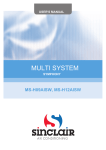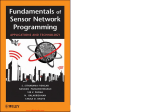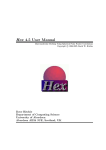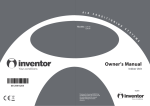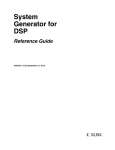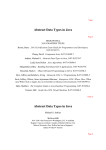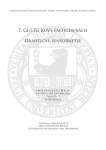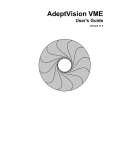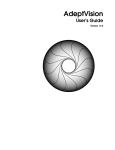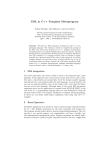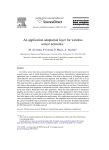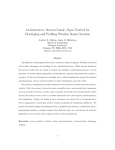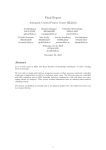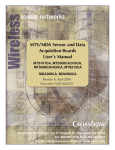Download WaveScript Rev 3657 User Manual
Transcript
WaveScript Rev 3657 User Manual
November 12, 2008
Contents
1 Introduction
1.1 A taste of the language . . . . . . . . . . . .
1.2 Pragmatics: Using WaveScript . . . . . . . .
1.2.1 ws: The Interactive Scheme Backend .
1.3 Premier Compiler Backends . . . . . . . . . .
1.3.1 The WaveScript MLton Backend . . .
1.3.2 The “Low-Level” C Backend . . . . .
1.3.3 The NesC/TinyOS 2.0 Backend . . . .
1.4 Deprecated Compiler Backends . . . . . . . .
1.4.1 The WaveScript CaML Backend . . .
1.4.2 The C++/XStream Backend . . . . .
.
.
.
.
.
.
.
.
.
.
.
.
.
.
.
.
.
.
.
.
.
.
.
.
.
.
.
.
.
.
.
.
.
.
.
.
.
.
.
.
.
.
.
.
.
.
.
.
.
.
.
.
.
.
.
.
.
.
.
.
.
.
.
.
.
.
.
.
.
.
.
.
.
.
.
.
.
.
.
.
.
.
.
.
.
.
.
.
.
.
.
.
.
.
.
.
.
.
.
.
.
.
.
.
.
.
.
.
.
.
.
.
.
.
.
.
.
.
.
.
.
.
.
.
.
.
.
.
.
.
.
.
.
.
.
.
.
.
.
.
.
.
.
.
.
.
.
.
.
.
.
.
.
.
.
.
.
.
.
.
.
.
.
.
.
.
.
.
.
.
.
.
.
.
.
.
.
.
.
.
.
.
.
.
.
.
.
.
.
.
.
.
.
.
.
.
.
.
.
.
.
.
.
.
.
.
.
.
.
.
.
.
.
.
.
.
.
.
.
.
.
.
.
.
.
.
.
.
.
.
.
.
.
.
.
.
.
.
.
.
.
.
.
.
.
.
.
.
.
.
.
.
.
.
.
.
.
.
.
.
.
.
.
.
.
.
.
.
.
.
.
.
.
.
.
.
.
.
.
.
.
.
.
.
.
.
.
.
.
.
.
.
.
.
.
.
.
.
.
.
.
.
.
.
.
.
.
.
.
.
.
.
.
.
.
.
.
.
.
.
.
.
.
.
.
.
.
.
.
.
.
.
.
.
.
.
.
.
.
.
.
.
.
.
.
.
.
.
.
.
.
.
.
.
.
.
.
.
.
.
3
3
4
4
5
5
5
5
6
6
6
2 Language Basics
2.0.1 Streams . . . . . . . . . . . . . .
2.0.2 Defining functions . . . . . . . .
2.0.3 Constructing complete programs
2.0.4 Tips for C/Java Programmers . .
2.1 Datatypes . . . . . . . . . . . . . . . . .
2.1.1 Tuples . . . . . . . . . . . . . . .
2.1.2 Numbers . . . . . . . . . . . . .
2.1.3 Lists . . . . . . . . . . . . . . . .
2.1.4 Arrays . . . . . . . . . . . . . . .
2.1.5 Extensible Records . . . . . . . .
2.1.6 Additional primitive functions .
2.2 Type Annotations . . . . . . . . . . . .
2.2.1 Reading data with readFile . . .
2.2.2 Type Aliases . . . . . . . . . . .
2.3 Sigsegs . . . . . . . . . . . . . . . . . . .
2.4 Namespaces . . . . . . . . . . . . . . . .
2.5 Patterns . . . . . . . . . . . . . . . . . .
2.6 Syntactic Sugar . . . . . . . . . . . . . .
2.6.1 Dot syntax . . . . . . . . . . . .
2.6.2 $: “Unary parentheses” . . . . .
2.6.3 Stream Projectors . . . . . . . .
.
.
.
.
.
.
.
.
.
.
.
.
.
.
.
.
.
.
.
.
.
.
.
.
.
.
.
.
.
.
.
.
.
.
.
.
.
.
.
.
.
.
.
.
.
.
.
.
.
.
.
.
.
.
.
.
.
.
.
.
.
.
.
.
.
.
.
.
.
.
.
.
.
.
.
.
.
.
.
.
.
.
.
.
.
.
.
.
.
.
.
.
.
.
.
.
.
.
.
.
.
.
.
.
.
.
.
.
.
.
.
.
.
.
.
.
.
.
.
.
.
.
.
.
.
.
.
.
.
.
.
.
.
.
.
.
.
.
.
.
.
.
.
.
.
.
.
.
.
.
.
.
.
.
.
.
.
.
.
.
.
.
.
.
.
.
.
.
.
.
.
.
.
.
.
.
.
.
.
.
.
.
.
.
.
.
.
.
.
.
.
.
.
.
.
.
.
.
.
.
.
.
.
.
.
.
.
.
.
.
.
.
.
.
.
.
.
.
.
.
.
.
.
.
.
.
.
.
.
.
.
.
.
.
.
.
.
.
.
.
.
.
.
.
.
.
.
.
.
.
.
.
.
.
.
.
.
.
.
.
.
.
.
.
.
.
.
.
.
.
.
.
.
.
.
.
.
.
.
.
.
.
.
.
.
.
.
.
.
.
.
.
.
.
.
.
.
.
.
.
.
.
.
.
.
.
.
.
.
.
.
.
.
.
.
.
.
.
.
.
.
.
.
.
.
.
.
.
.
.
.
.
.
.
.
.
.
.
.
.
.
.
.
.
.
.
.
.
.
.
.
.
.
.
.
.
.
.
.
.
.
.
.
.
.
.
.
.
.
.
.
.
.
.
.
.
.
.
.
.
.
.
.
.
.
.
.
.
.
.
.
.
.
.
.
.
.
.
.
.
.
.
.
.
.
.
.
.
.
.
.
.
.
.
.
.
.
.
.
.
.
.
.
.
.
.
.
.
.
.
.
.
.
.
.
.
.
.
.
.
.
.
.
.
.
.
.
.
.
.
.
.
.
.
.
.
.
.
.
.
.
.
.
.
.
.
.
.
.
.
.
.
.
.
.
.
.
.
.
.
.
.
.
.
.
.
.
.
.
.
.
.
.
.
.
.
.
.
.
.
.
.
.
.
.
.
.
.
.
.
.
.
.
.
.
.
.
.
.
.
.
.
.
.
.
.
.
.
.
.
.
.
.
.
.
.
.
.
.
.
.
.
.
.
.
.
.
.
.
.
.
.
.
.
.
.
.
.
.
.
.
.
.
.
.
.
.
.
.
.
.
.
.
.
.
.
.
.
.
.
.
.
.
.
.
.
.
.
.
.
.
.
.
.
.
.
.
.
.
.
.
.
.
.
.
.
.
.
.
.
.
.
.
.
.
.
.
.
.
.
.
.
.
.
.
.
.
.
.
.
.
.
.
.
.
.
.
.
.
.
.
.
.
.
.
.
.
.
.
.
.
.
.
.
.
.
.
.
.
.
.
.
.
.
.
.
.
.
.
.
.
.
.
.
.
.
.
.
.
.
.
.
.
.
.
.
.
.
.
.
.
.
.
.
.
.
.
.
.
.
.
.
.
.
.
.
.
.
.
.
.
.
.
.
.
.
.
.
.
.
.
.
.
.
.
.
.
.
.
.
.
.
.
.
.
.
.
.
.
.
.
.
.
.
.
.
.
.
.
.
.
.
.
.
.
.
.
.
.
.
.
.
.
.
.
.
.
.
.
.
.
.
.
.
.
.
.
.
.
.
.
.
.
.
.
.
.
.
.
.
.
.
.
.
.
.
.
.
.
.
.
.
.
.
.
.
.
.
.
.
.
.
.
.
.
.
.
.
.
7
7
8
8
8
8
8
8
8
9
9
9
10
10
11
11
11
11
11
11
11
12
3 Foreign (C/C++) Interface
3.1 Foreign functions . . . . . . .
3.2 Foreign Sources . . . . . . . .
3.3 Inline C Code . . . . . . . . .
3.4 Foreign code in TinyOS . . .
3.5 Other backend’s support . . .
3.6 Converting WaveScript and C
3.7 Importing C-allocated Arrays
3.8 “Exclusive” Pointers . . . . .
.
.
.
.
.
.
.
.
.
.
.
.
.
.
.
.
.
.
.
.
.
.
.
.
.
.
.
.
.
.
.
.
.
.
.
.
.
.
.
.
.
.
.
.
.
.
.
.
. .
. .
. .
. .
. .
. .
. .
. .
1
.
.
.
.
.
.
.
.
.
.
.
.
.
.
.
.
.
.
.
.
.
.
.
.
.
.
.
.
.
.
.
.
.
.
.
.
.
.
.
.
.
.
.
.
.
.
.
.
.
.
.
.
.
.
.
.
.
.
.
.
.
.
.
.
.
.
.
.
.
.
.
.
.
.
.
.
.
.
.
.
.
.
.
.
.
.
.
.
.
.
.
.
.
.
.
.
.
.
.
.
.
.
.
.
.
.
.
.
.
.
.
.
.
.
.
.
.
.
.
.
.
.
.
.
.
.
.
.
.
.
.
.
.
.
.
.
.
.
.
.
.
.
.
.
.
.
.
.
.
.
.
.
.
.
.
.
.
.
.
.
.
.
.
.
.
.
.
.
.
.
.
.
.
.
.
.
.
.
.
.
.
.
.
.
.
.
.
.
.
.
.
.
.
.
.
.
.
.
.
.
.
.
.
.
.
.
.
.
.
.
.
.
.
.
.
.
.
.
.
.
.
.
.
.
.
.
.
.
.
.
.
.
.
.
.
.
.
.
.
.
.
.
.
.
.
.
.
.
13
13
13
14
14
15
15
15
16
. . . .
. . . .
. . . .
. . . .
. . . .
types
. . . .
. . . .
.
.
.
.
.
.
.
.
.
.
.
.
.
.
.
.
4 Standard Libraries
4.1 stdlib.ws . . . . . . . . . .
4.2 Fourier Transforms . . . . .
4.3 Matrix Operations . . . . .
4.3.1 Other numeric types
4.3.2 Matrix Interface . .
.
.
.
.
.
17
17
17
17
17
17
5 WaveScript Evaluation Model
5.1 Execution Model . . . . . . . . . . . . . . . . . . . . . . . . . . . . . . . . . . . . . . . . . . . . . . . . . . . .
19
19
A Primitive table
20
.
.
.
.
.
.
.
.
.
.
.
.
.
.
.
.
.
.
.
.
.
.
.
.
.
.
.
.
.
.
.
.
.
.
.
.
.
.
.
.
.
.
.
.
.
.
.
.
.
.
.
.
.
.
.
.
.
.
.
.
.
.
.
.
.
.
.
.
.
.
2
.
.
.
.
.
.
.
.
.
.
.
.
.
.
.
.
.
.
.
.
.
.
.
.
.
.
.
.
.
.
.
.
.
.
.
.
.
.
.
.
.
.
.
.
.
.
.
.
.
.
.
.
.
.
.
.
.
.
.
.
.
.
.
.
.
.
.
.
.
.
.
.
.
.
.
.
.
.
.
.
.
.
.
.
.
.
.
.
.
.
.
.
.
.
.
.
.
.
.
.
.
.
.
.
.
.
.
.
.
.
.
.
.
.
.
.
.
.
.
.
.
.
.
.
.
.
.
.
.
.
.
.
.
.
.
.
.
.
.
.
.
.
.
.
.
.
.
.
.
.
.
.
.
.
.
Chapter 1
Introduction
WaveScript is a functional language for writing highly
abstract programs that generate efficient dataflow graphs
through a two-stage evaluation model. These graphs are
executable in several backends (Scheme, ML, C, Java,
TinyOS) that offer different tradeoffs in features, performance, and compile times, as well as parallel and distributed
execution. The compiler has several command line entrypoints for the different backends.
1.1
main = iterate x in timer(10.0) {
emit "Hello world!";
emit "Hello again!";
}
Actually, timers are the only built-in WaveScript stream
sources. All other built-in stream procedures only transform
existing streams.
Iterate also allows persistent, mutable state to be kept between invocations. This is introduced with the sub-keyword
state. For example, the following produces an infinite
stream of integers counting up from zero.
A taste of the language
The academic publications on WaveScript will give you a
top-down account of its features, reason for being, and so
on. In this manual, our goal is instead to introduce you to
programming in WaveScript in a bottom-up manner. We’ll
start from “Hello-world” and proceed from there.
Here’s a simple but complete WaveScript program:
main = iterate x in timer(10.0) {
state { cnt = 0; }
emit cnt;
cnt := cnt + 1;
}
main = timer(10.0)
Notice that the assignment operator for mutating mutable variables (:=) is different than the operator used for
declaring new variables (=). (WaveScript also has +=, -= etc
for use in mutating variables.) It is also possible for mutable
state to be declared outside the scope of the iterate, but
that introduces the possibility of referring to the state from
the bodies of two different iterates, which is not allowed.
As a final example, we’ll merge two streams operating at
different frequencies.
This creates a timer that fires at 10hz. The return value
of the timer function is a stream of empty-tuples (events
carrying no information). The return value of the whole
program is, by convention, the stream named “main”. The
type of the above program is Stream (), where () designates the empty-tuple.
In our next program, we will print “Hello world” forever.
main = iterate x in timer(10.0) {
emit "Hello world!";
}
The iterate keyword provides a special syntax for accessing every element in a stream, running arbitrary code using
that element’s value, and producing a new stream as output. In the above example, our iterate ignores the values
in the timer stream (“x”), and produces one string value
on the output stream on each invocation (thus, it prints
“Hello world!” at 10hz). The type of the program is Stream
String.
Note, that we may produce two or more elements on the
output stream during each invocation. For example, the
following would produce two string elements for each input
element on the timer stream.
s1 = iterate x in timer(3.0) { emit 0; }
s2 = iterate x in timer(4.0) { emit 1; }
main = merge(s1,s2)
This will output a sequence of zeros and ones, with four
ones for every three zeroes. The merge operator combines
two streams of the same type, interleaving their elements in
real time.
Before we get into the nitty gritty, I will leave you with
two high-level points regarding how you should think of
WaveScript.
3
1. Everything is a value. Streams and functions are
just values (or objects if your prefer). The purpose of
a WaveScript program is to return a Stream.
2. But you need to understand multi-stage evaluation. There are some restrictions on the code that
executes inside iterates, having to do with what features are supported at runtime vs. compile time. This
detracts from the simplicity of (1), because, for example, function values may not be stored at run time.
We’ll return to this issue in Chapter 5.
1.2
fly. Compile time is low, because we need not call a separate
backend compiler. However, performance is not as good as
the other backends we will discuss. Further, the Scheme
backend does not support external (real time) data sources,
only queries running in virtual time using data stored in
files.
One major advantage of the Scheme backend is that it’s
interactive. The query starts up paused, and the user may
step through and inspect the elements of the output stream.
Thus the user may pull on the stream rather than being
pushed a torrent of output.
Pragmatics: Using WaveScript
This section addresses pragmatic issues concerning invoking
the system and running dataflow graphs. If you are new
to WaveScript, it may help to skip to chapter 2 to get a
sense for the language itself, then come back to this section
afterwards.
Variants of ws
There are several other useful ways to invoke WaveScript
with the Scheme backend.
Installing
Consider ws.opt for higher performance
See the README for install instructions. The bottom line
is that you will need Mzscheme and Petite Chez Scheme
to run the WaveScript compiler and the Scheme backend.
(Petite for Linux is included in the repository.) You will
need Boost, the Gnu Scientific Library (GSL), FFTW, and
their respective headers to run compiled C++ code.
Once the system is installed you should be able to execute ws on any WaveScript source files (.ws files). This
will compile the query and execute it directly in the Scheme
backend. Other backends (and variations on this one) will
be discussed in this section.
The first thing to do to improve the performance of ws is
make sure that you have the full version of Chez Scheme.
This version includes the incremental native code compiler.
If you are using the free, Petite Chez Scheme interpreter,
your .ws query files will be converted to interpreted Scheme
code, which runs considerably slower. The executable chez
should be in your path.
To go further, you might consider running ws.opt in
place of ws. First, ws.opt has debugging assertions disabled. Second, ws.opt is compiled in the highest Chez
Scheme optimize level, and also compiles your query in this
higher optimize level. However, this optimize level is dangerous in that it omits various checks necessary to maintaining type safety. Thus the process can crash if there’s an
error, or memory can become corrupted (just like C/C++).
Therefore, debug your code using ws first.
Develop Incrementally
WaveScript is a research compiler. It doesn’t offer the same
level of support that you expect from production-quality
compilers. Sometimes the error messages might be difficult to interpret. (However, the type checker messages have
been improved immensely and do include code locations
[04/08/2007].)
Therefore it helps to build your program bit by bit. Compile often to make sure that the pieces of your program parse
and type-check.
wsparse: While entrypoints such as ws parse source files
internally, if you want the full error message for a parser
error (including line and column number!), run wsparse directly on the .ws file. It will either print the AST (abstract
syntax tree) for the file, or will give you an error message
that does include line and character numbers.
1.2.1
Run ws.debug occasionally for sanity-checking
Ws.debug is too slow for the normal development cycle, but
it is important to occasionally compile your program with
ws.debug. Mainly this is important for building confidence
that the compiler is behaving properly on your program. If
the compiler were a mature system not under active development, this would not be as important.
Specifically, when you run ws.debug:
1. It turns on extra ASSERT statements in the code that
check data structure invariants to help ensure proper
operation.
2. It dumps the whole program at several points in the
compilation to files such as “. elaboratedprog.ss”. It
can be helpful to look at these for debugging.
ws: The Interactive Scheme Backend
Running the command “ws mysource.ws” will compile
your source file, and execute the resultant dataflow graph
directly within Scheme, without generating code for another
platform. The dataflow graph is converted to a Scheme program which is compiled to native code and executed on the
4
3. It includes additional type checks of the entire program
between passes (regular ws type checks several times,
but ws.debug does more). This helps expose compiler
bugs.
4. Finally, it does “grammar checks” on the output of each
compiler pass. Each pass includes a BNF grammar that
describes its output. ws.debug mechanically checks to
make sure every intermediate expression conforms to
the appropriate grammar. Again, this helps to expose
compiler bugs.
This backend “inherits” from wsc2 and modifies it to
support TinyOS. As of this writing [2008.02.22], the TinyOS
backend is limitted in its supported language features. (See
the end of this section for a list of limitations.)
wstiny can be invoked in multiple ways. First, simply
invoking wstiny on a WaveScript file (in the same way as
any other backend) will compile the entire application to
run on the mote.
For very low compile times: ws.early
If you are running many small programs — stream “queries”
— then the latency of compilation may be more important
to you than the throughput of the query once it is running.
In this case it is reasonable to use ws.early.
1.3
[joe@computer] wstiny demo11g_tinyos.ws
In the same way that one invokes “query.exe” or
“query.mlton.exe” when using another WaveScript backend, one can run the wstiny program with “query.py”:
Premier Compiler Backends
[joe@computer] ./query.py
1.3.1
The WaveScript MLton Backend
This is a python script that invokes TOSSIM, the TinyOS
simulator. The output of the program will be printed to the
terminal—including printed output and return values on the
main stream—again, just like any other backend.
Of course, the point of compiling for TinyOS is to run
code on a mote! This is slightly more involved. After executing wstiny, we need to build the binary for the particular
mote platform. And then we invoke a listener on the serial
port to see the output of the program.
The WaveScript Scheme backend (ws) provides a reference
implementation suitable to prototyping and debugging applications. The eventual target for most WaveScript programs is to generate an efficient stand-alone binary using
one of our other backends. One of these backends is the
MLton backend, invoked with wsmlton.
MLton is an aggressive, whole-program optimizing compiler for Standard ML. Generating ML code from the WaveScript dataflow graph is straightforward because of the similarities between the languages’ type systems. This provides
us with an easy to implement single-threaded solution that
exhibits surprisingly good performance [?], while also ensuring type- and memory-safe execution.
1.3.2
[joe@computer]
[joe@computer]
[joe@computer]
[joe@computer]
The “Low-Level” C Backend
wstiny has polluted your working directory with several files, including Makefile.tos2, PrintfClient.java,
query.py and others. The PrintfClient program can listen
to a particular device specified either through the MOTECOM
environment variable, or through a “-comm” flag. Please
refer to the the TinyOS documentation for instructions on
how to connect motes to your computer.
Invoked with “wsc2”.
Moving forward, this will serve as the primary WaveScript backend. It has three purposes. First, it generates
the most efficient code. Second, it serves as a platform for us
to build custom garbage collectors (the C++ backend simply uses Boost smart pointers) and experiment with other
aspects of the runtime. Third, it generates code with minimal dependencies (not requiring a runtime scheduler). This
last point was critical in adapting the backend to target
TinyOS (described in the next section).
Currently [2008.08.15], wsc2 includes several garbage
collection modes (simple reference counting, specialized deferred reference counting, boehm), has some support for
multithreaded execution, some support for client/server
execution over a LAN using ssh, and some support for
client/server execution over a network of sensor nodes running JavaME or TinyOS and a base station. (See the following section.)
1.3.3
Executing across mote and PC
The NesC/TinyOS 2.0 Backend
Invoked with “wstiny”.
make -f Makefile.tos2 telosb install
MOTECOM=serial@/dev/ttyUSB0:telosb
export MOTECOM
java PrintfClient
5
Alas, it is not very interesting to simply run code on a mote
that is attached to a PC’s serial port. For a real sensor
network application, we need to run WS code on an entire
sensor network and on the PC connected to the network,
seemlessly splitting the application across the two tiers.
Currently, wstiny supports a method for manually splitting programs across tiers. This is implemented using a
simple naming convention. A “Node” namespace contains
all the streams that will live inside the network, and everything outside of that namespace lives on the PC. The
following program illustrates this method, but it may help
to return to it after reading Section 2, and in particular
Section 2.4 which explains namespaces.
• Only string constants, static arrays, numbers, and tuples are currently supported.
namespace Node {
s1 = ...
s2 = ...
}
main = smap((+ 1), Node:s2);
• Not all datatypes can be sent across a “cut” stream.
Currently, tuples and numbers support marshaling (including nested tuples). Arrays support marshaling but
*only* if the array is not contained within a tuple.
Only the “(+ 1)” operation is executed on the PC. The
“cut point” that splits s2 between the mote and PC will
cause the compiler to generate code on both sides that accomplishes the communication. To compile this program,
and execute it across the PC and a single mote connected
to a serial interface, we type the following:
Future plans
We are in the process of removing the above limitations and
adding support for new features:
• Dynamic allocation and garbage collection.
[joe@computer] wstiny -split demo11g_tinyos.ws
[joe@computer] make -f Makefile.tos2 telosb install
[joe@computer] ./query.exe
• Automatic and semi-automatic partitioning of stream
programs across PCs and motes.
First, we compile the program, producing code for both
platforms. Second, we install the progam onto the mote.
Third, we execute the PC portion of the program, which
listens to the serial port, unpacks the messages from the
stream s2, and executes the rest of the program, producing
output to stdout as usual. If we had compiled without
-split, then the entire application would run on the mote.
Note, the mote-side communication is accomplished using the TinyOS interface AMSend, which by default is wired
to a SerialAMSenderC component. If we want to execute on
more than one mote, we must instead wire this interface to
the radio (the AMSenderC component). This is accomplished
with:
1.4
1.4.1
Deprecated Compiler Backends
The WaveScript CaML Backend
This backend is no longer supported and will receive no new
features! But if you need to use it, let me know.
1.4.2
The C++/XStream Backend
This backend is no longer supported and will receive no new
features! But if you need to use it, let me know.
The C++ backend1 generates code that uses the
XStream runtime/scheduling engine. It is invoked with the
wsc command. In practice, as WaveScript undergoes development, the wsc compiler often lags behind ws in terms
of features and functionality. Again, develop incrementally,
refer to demos/wavescope for programs that should work
with wsc.
Refer to the XStream documentation2 for information on
how to configure the XStream engine (number of threads,
scheduling policy, etc)).
[2007.03.09] Ideally the output from the XStreamexecuted query would be the same as the ws’s output. Currently, however, there are some basic disparities in how objects are printed to text form. Hopefully, these are straightforward to work around, and should go away.
Note that the C++/XStream backend does not have
competitive performance with either the MLton backend or
the newer ANSI C backend (wsc2).
[joe@computer] wstiny -split-radio demo11g...
Which is just shorthand for:
[joe@computer] wstiny -split-with "AMSenderC" ...
The resulting NessC code can be used to program several motes. Then the TinyOS-included “BaseStation” application can be used to enable a PC to receive these radio
messages on its serial port. This method described in the
here: Lesson 4: Mote-PC serial communication.
Note that the semantics of this method is that the messages from every mote’s s2 stream are combined to form
the s2 stream seen on the PC. Thus, the s2 streams will
most likely include the a node identifier so that the PC can
demultiplex the stream. Please see Section 3.4 for information on integrating legacy TinyOS code with a WaveScript
application.
Limitations
• The above -split methodology only works for one-hop
networks. We must adapt it to use the CTP (Collection
Tree Protocol) to work over larger networks.
• Code running on motes may not currently allocate
memory dynamically.
6
1 It uses a C++ compiler not because it generates object-oriented
code, but because the XStream runtime engine it links with has been
engineered in C++.
2 [2007.03.09] Currently nonexistent
Chapter 2
Language Basics
Please make liberal use of the demo files located at
demos/wavescope/*.ws as a reference when learning WaveScript. These demos cover most of the basic functionality
in the language.
Wavescript is a functional language with many similarities to ML or Haskell. Functions are values. The language
is strongly typed and uses a type-inference algorithm to infer types from variable usages. It provides the usual basic
datatypes, including various numeric types, strings, lists,
arrays, hash tables as well as the more WaveScript-specific
Streams and Sigsegs. Valid expressions in WaveScript are
written much as in C.
sions, they sometimes must be followed with a semi-colon,
as below:1
arithmetic : 3 + 4 * 10
f unction calls : f(x, y)
blocks : { e1 ; e2 ; ... en }
[2007.03.09] Be wary that with the current parser, a semicolon error may appear as a strange parse error in the next
or previous line.
{
foo;
if b then {
bar();
} else {
baz();
}; <-- SEMICOLON REQUIRED
done();
}
But there are also many syntactic differences from C. For
example, WaveScript doesn’t have a sharp division between
commands and expressions. Conditionals use a different
syntax and are valid in any expression position.
→
3 + (if true then 1 else 2)
2.0.1
WaveScript is for stream-processing and it would be useless
without Streams. Streams in WaveScript are like any other
values: bound to variables, passed and returned from functions. The primary means of operating on the data inside
streams is the iterate syntactic construct.
4
(Note that the arrow above means “evaluates to”, but WaveScript does not currently have an interactive read-eval-printloop in which you can type such incomplete program fragments.)
Moreover, blocks in WaveScript—delimited by curly
braces—are just expressions!
3 + {1; 2; 3}
→
S2 = iterate x in S1 {
state{ counter = 0 }
counter := counter + 1;
emit counter + x;
}
The iterate construct can be placed in any expression
position. It produces a new stream by applying the supplied code to every element of its input stream. The above
example executes the body of the iterate every time data
is received on the stream S1, it adds an increasing quantity
to each element of S1, and the resulting stream is bound to
the variable S2.
In addition to iterate several library procedures (such
as stream map) and many primitives (such as unionList)
operate on Stream values. For example, merge combines
6
This is similar to the begin/end blocks found in other functional languages, or the “comma operator” sequencing construct in C++. Only the value of the last expression within
the block is returned, the other statements/expressions only
bind variables or perform side effects.
Note that this different convention makes semi-colon usage in WaveScript somewhat unintuitive. Within blocks,
semi-colons are only required as separators; they are permitted, but not required after the last expression in the block.
Also, since curly-brace delimited blocks are merely expres-
Streams
1 As
7
a special case, when a function body consists of curly braces,
it needn’t be followed by a semi-colon.
C/C++ code
int x = 3;
two streams of the same type (their tuples interleaved in
real time), whereas unionList also combines streams of the
same type, but tags all output tuples with an integer index
indicating from which of the input streams it originated.
2.0.2
x = 4;
if (a) b; else c;
typedef char myty;
List< Array<int> >
Defining functions
Named functions can be defined at the top-level, or within
a {...} block, as follows:
fun f(x,y) {
z = x+y;
sqrt(z)
}
WS Equivalent
x = 3;
OR
x = (3::Int);
x::Int = 3;
x := 4;
if a then b else c;
type myty = Char;
List (Array Int)
Figure 2.1: Some highlighted syntactic differences between
WaveScript and C/C++/Java.
2.1
The function body, following the argument list can be
any expression. Above it happens to be a statement block
that returns the square-root of z.
Unnamed, or anonymous, functions can occur anywhere
that an expression might occur. In the following we pass
an anonymous “plus three” function as the first input to
stream map. Note that the body of the function is a single
expression, not a statement block, and is not delimited by
curly braces.
Datatypes
This section goes over syntax and primitives for manipulating built-in data structures.
2.1.1
Tuples
Tuples, or product types, are ordered sets of elements which
can each be of different types.
→
(1,‘‘hello’’)
A tuple of type (Int * String)
stream map(fun(x) x+3, S)
2.0.3
Tuples are accessed by a pattern-matching against them and
binding variable names to their constituent components.
This process is described in section 2.5.
Constructing complete programs
A complete program file contains function and variable declarations. As seen in Section 1.1, a special variable declaration binds the name “main” to a stream:
2.1.2
WaveScript supports several different types of numbers.
Currently, this set includes Int, Int16, Uint16, Int64, Float,
Double, Complex, but it will be extended to include 8bit integers, other unsigned integers, and complex-doubles.
WaveScript includes generic numeric arithmetic operations
(+, −, ∗, /) that work for any numeric types, but must be
used on two numbers of the same type. There are also typespecific numeric operations that are not used frequently:
main = stream-valued-expression;
As a side-note, WaveScript can be called with a “-ret foo”
flag to return the stream “foo” instead of the stream “main”.
This is frequently useful for invoking testing entrypoints as
well as the production entrypoint for the program.
Note also that only the returned stream is instantiated at
runtime. Other streams declared in the program will simply
be ignored. They become dead code.
2.0.4
generic
Int
F loat
Complex
Int16
Int64
Tips for C/Java Programmers
As a quick cheat sheet, refer to Figure 2.1. This addresses
some minor syntactic differences between WS and C/C++
that commonly trip people up.
One important piece of advice is to be careful with mutation (:=). Don’t use it when it’s unnecessary! And if you
need to use it, keep the scope of the variables in question
as small as possible. If, for example, you introduce mutable
top-level (global) variables it may have major deleterious
effects. First of all, it opens up the possibility that you
will refer to the state from multiple iterate bodies, which
will make the compiler yell at you. More subtly, it can disable optimizations that act on iterates without persistent
state—for example, replicating them in parallel.
Numbers
:
:
:
:
:
:
+ - * / ^
+ - * / ^
+. -. *. /. ^.
+: -: *: /: ^:
+I16 -I16 *I16 /I16 ^I16
+I64 -I64 *I64 /I64 ^I64
Other numeric operations, such as abs or sqrt, follow
the naming convention absI for integers, absF for floats,
absC for complex, and absI16 for 16-bit integers. Eventually, WaveScript will include a type-class facility which will
simplify the treatment of numeric operations.
2.1.3
8
Lists
Lists can be written as constants and support the usual
primitive operations.
In WaveScript, records are constructed in a manner similar to tuples, but with the labels on each data field. Data
fields can then be extracted using then common “dot syntax”.
ls = [1, 2, 3];
ls2 = head(ls):::ls;
print(List:length(ls2)); // Prints ’4’
print(ls == []);
// Prints ’false’
r = (A=3, B=true)
x = r.A
The ::: operator adds an element to the front of a list.
Also use head, tail, List:reverse, List:append to operate on lists.
Other operations include, but are not limited to the following. List:zip combines two equal-length lists into a list
of two-tuples. List:map(f,ls) returns a new list generated
by applying the function f to each element of the input list.
List:filter(pred,ls) returns only those elements of the
list that satisfy pred. List:fold(op,init,ls) reduces a
list by repeatedly applying op to pairs of elements, for example, to sum the elements of a list. List:mapi(f,ls) is a
variant of map that also passes the index of the element to
the input function. List:foreach(f,ls) applies a function
to each element for side effect only, not building a new list.
List:build(len, f) builds a new list, using a function (on
index) to populate each position in the list.
Many of these operators (map, filter, foreach, mapi, fold,
build, etc) are used consistently for different container types
(lists, arrays, matrices, etc).
2.1.4
But records can also be extended with new fields. This uses
a “bar” syntax as follows:
( r | A=3)
(A=3) == (|A=3)
( r | ~A, B=4)
// Remove field A, add field B
Removing a field and then replacing it is a common idiom,
and has a special syntactic sugar:
( r | ~B, B = 4) // Remove field B, add new B
( r | B := 4)
// Shorthand for the same
Field labels are required to begin with capital letters in
WaveScript. This is to avoid conflict with another use of
the dot syntax.
Extensible records are particularly useful in a streaming
language like WaveScript. In WaveScript, the only communication between different parts of the program is through
streams. Thus we typically need to pack data together to
travel on a stream (for example, raw data plus metadata).
With extensible records, it is possible to write an application
as a series of modular components that take and produce
records—consuming some fields, and adding others, while
remaining agnostic to the presence of unused fields:
Arrays
// Function foo takes a record that has at
// least X,Y. (But might have other fields.)
fun foo(r) {
n = f(r.X, r.Y);
( r | Z=n )
// add new results field
}
Extensible Records
Tuples are useful for packing together a small number of
data items. But from a software engineering perspective
they have a number of limitations. First, they quickly grow
confusing as the number of items increases. Second, they
require that client code be fully aware of all the data inside
the tuple (and thus be fragile and difficult to refactor).
A solution to the first problem is to use named fields.
Tuples with named fields are called “records” (similar to C
structs). A solution to the second problem is to make those
records extensible. WaveScript implements the extensible
record system documented in the paper “Extensible Records
with Scoped Labels” by Dan Leijen.
// Extend a record r
// The bar is optional here
When updating records, it is also possible to remove
fields:
Arrays, unlike lists, are mutable. Use a hash symbol to build
a constant array rather than a list, for example #[1,2,3].
Use Array:make to allocate new arrays. The Array:ref
and Array:set primitive access arrays elements, but it’s
shorter to use the syntactic sugar, arr[i] to access arrays,
and arr[i] := x; to modify them. Nested array references work as expected, as do the += style shorthands, e.g.
arr[i][j] += 3. However, to use these shorthands with
an arbitrary, non-variable expression extra parentheses are
required: (f(x))[i].
Many array operations are analogous to the list operations (map, fold, etc). See the documentation for additional
primitives below.
2.1.5
// Record construction
// Extract the field ’A’
This form of processing is very common in stream SQL
dialects, but here can be used in a more general purpose
language with type-inference.
2.1.6
Additional primitive functions
Appendix A contains a table of all currently supported
WaveScript primitives, together with their type signatures.
For more documentation on these primitives, please refer
to this file within your working copy:
src/generic/
compiler components/prim defs.ss
9
You can find the online documentation at:
[2007.03.09] In the future, the user will be able to create
their own type definitions and type constructors, including
tagged-union or sum types.
http://regiment.us/codedoc/html/generic/compiler_
components/prim_defs.ss.html
This file contains type-signatures (and minimal documentation) for all built-in wavescript primitives, many
of which are not covered in this manual.
Within
the online documentation linked above you should look
at regiment-primitives which is defined in terms of
regiment-basic-primitives, regiment-distributed-primitives,
wavescript-primitives, meta-only-primitives, higher-orderprimitives, and regiment-constants .
Please also examine the library files found in the lib/
sub-directory. These files, for example ‘‘stdlib.ws’’ and
‘‘matrix.ws’’, include library routines written in WaveScript. As a general design principle, it is best to implement
as much as possible in the language, while keeping the set
of built-in primitives relatively small.
For various historical reasons there are several primitives
included in the current primitive table that should not ultimately be primitive. These will eventually be removed and
implemented instead as library routines. Likewise, there are
certainly many additional primitives that one might like to
see incorporated as the language matures.
2.2
2.2.1
The one place where type annotations are currently mandated is when importing data from a file. This is done with
the primitive readFile. Readfile is not a stream source,
but rather is driven by another stream, reading a tuple from
the file for every element on its input stream. This makes
it more general.
main =
(readFile("foo.txt", "", timer(10.0))
:: Stream (Int16 * Float))
The above complete program reads space-separated values from a text file, one-tuple-per-line. In this case, each
tuple contains two values: a 16 bit integer, and a floating
point value. The readFile primitive may also be used to
read data from a file in blocks (Sigsegs), which is generally
more efficient. All that is required is to specify a stream of
Sigseg type, as follows.
Type Annotations
main =
(readFile("foo.dat",
"mode: binary repeat: 3",
timer(10.0))
:: Stream (Sigseg Int16))
We have already seen several types in textual form within
this manual: Float, (Int * String) These are valid WaveScript types. WaveScript also has compound types such as
Sigseg (Array Int).
Similar to Haskell or ML, the user is permitted, but not
generally required to add explicit type annotations in the
program. For example, we may annotate a function f with
its type by writing the following.
Also note that the second argument to readFile is an
option string. This string is parsed at compile time (during meta-program evaluation). The string must contain a
(space separated) list of alternating option names and option values. The following are the available options, and
their default values.
f :: (Type, Type) -> Type;
fun f(x,y) { ... }
• mode: one of ’text’ or ’binary’ (default ’text’)
Indeed, a type annotation may be attached to any expression with the following syntax:
(expression ::
• repeats: a number specifying whether to replay the
file’s contents when the end of file is reached. Set to a
non-negative integer to specify the number of repeats,
or to -1 to repeat indefinitely. (default 0)
Type)
Further, type annotations may be added to variable declarations with:
var ::
• rate: the rate (in tuples per second) to play the back
the data from the file. For the emulator, this refers
to virtual time, and is used only to maintain relative
timing of different data streams. Note that this is orthogonal to windowing; whether data is windowed or
not, the rate will be interpreted in the same way. (default 1000)
Type = expression;
In general, compound types may be built from other
types in several ways.
tuples
lists
arrays
hashtables
f unctions
:
:
:
:
:
(T1 * T2 * T3)
List T1
Array T1
HashTable (T1,T2)
(T1, T2, T3) -> T4
Note that parentheses must be used when nesting type constructors as in List (List T).
Reading data with readFile
• offset: The offset, in bytes, at which to start reading
from the file. (default 0)
10
• skipbytes: The number of bytes to skip between reading each tuple from the data file. (default 0)
• window: If the output stream is blocked into Sigsegs
(windows), this parameter determines the size of each
Sigseg. (default 1)
2.2.2
Let’s look at an example. We saw how to bind variables
in WaveScript:
z = (1,2);
Type Aliases
This binds z to a tuple containing two elements. This is
actually a shorthand for the more verbose syntax:
Because types can grow large and complex, it is often helpful to define aliases, or shorthands, similar to C/C++’s
typedefs.
type
type
type
type
MyType
MyType2 t
MyType3 (x)
MyType4 (x,y)
=
=
=
=
let z = (1,2);
An unfortunate limitation of the parser is that ’let’
cannot be omitted if we a pattern is used in place of a simple
identifier. The following binds the individual components of
the tuple by using a pattern in place of the variable ’z’:
List Int;
Stream (List t);
List (x);
List (x * y);
let (x,y) = (1,2);
x :: MyType;
x = [3];
Similarly, we may use patterns within a function’s argument list. Here’s a function that takes a 2-tuple as its
second argument:
s1 :: MyType2 Int;
...
2.3
fun foo (x,(y,z)) { . . . }
Sigsegs
2.6
Sigsegs are a flexible ADT for representing windows of samples on a stream. Please refer to the CIDR’07 publication
with the title “The Case for a Signal-Oriented Data Stream
Management System” for details. Also check prim defs.ss
for the specific names and type signatures of the Sigseg
primitives.
2.4
Syntactic sugars are convenient shorthands that are implemented by the parser and make programming in WaveScript
more convenient (at the risk of making reading code more
difficult for the uninitiated).
2.6.1
namespace Foo {
x = ...;
y = ...;
}
var = Foo:x + Foo:y;
fun f() {
using Foo;
var = x + y;
}
Patterns
WaveScript allows pattern matching in addition to plain
variable- In any variable-binding position it is valid to use
a pattern rather than a variable name—this includes the
arguments to a function, a local variable binding, or the
variable binding within an iterate construct. Currently,
patterns are used to bind names to the interior parts of
tuples. In the future, we will support list patterns, and
tagged union patterns.
Dot syntax
For convenience, functions can be applied using an alternative “dot syntax”. For example rather than taking the first
element of a list with “head(ls)”, we can write “ls.head”.
This generalizes to functions of more than one argument;
only the first argument is moved before the dot. For example,
List:ref(ls,i)
may be written as
ls.List:ref(i)
This is useful because many functions on data structures
take the data structure itself as their first argument. Thus
it is concise to write the following:
ls.tail.tail.head
Note that this syntax requires that the name of the function
(not counting namespace modifiers) begin with a lower case
letter. This is to avoid ambiguity with record field projection (see Section 2.1.5).
Namespaces
WaveScript, while not having a sophisticated module system, does include a simple system for managing namespaces.
2.5
Syntactic Sugar
2.6.2
11
$: “Unary parentheses”
The “$” operator for procedure application is taken from
Haskell and sometimes called the “unary parenthesis”. Instead of f(g(x)), we write “f $ g $ x”. This is useful if
you have a large expression spanning many lines to which
you want to apply a function:
iterate x in strm {
(many lines) ...
We can apply a function myfunction without scrolling down
to insert a close parenthesis:
myfunction $
iterate x in strm {
(many lines) ...
2.6.3
Stream Projectors
WaveScript also includes a syntax for binding streams of
tuples in a way that associates a projector function for each
of the tuples’ fields. For example:
S as (a,b) = someStream;
Subsequently, “S.(a)” or “S.(a,b,a)” can be used to
project a new stream where each tuple represents an arrangement of the fields within each tuple in S. If used in
conjunction with the type-annotation syntax, note that the
“as” clause must go first:
S as (a,b) ::
Stream(Int * Float) = someStream;
12
Chapter 3
Foreign (C/C++) Interface
The WaveScript compiler provides a facility for calling
external (foreign) functions written in C or C++. The primary reasons for this are two-fold.
Currently C-code can be loaded from source files (.c,
.cpp) or object files (.o, .a, .so). When loading from object files, it’s necessary to also include a header (.h, .hpp).
For example:
1. We wish to reuse existing libraries without modification
(e.g. Gnu Scientific Library, FFTW, etc).
c_bar =
(foreign("bar", ["bar.h", "bar.a"])
:: Int -> Int)
2. We wish to add new stream sources and sinks — for
network communication, disk access and so on — without modifying the WaveScript compiler itself. Also, we
frequently want to add support for new hardware datasources (sensors).
Of course, you may want to import many functions from
the same file or library. WaveScript uses a very simple rule.
If a file has already been imported once, repeated imports
are suppressed. (This goes for source and object files.) Also,
if you try to import multiple files with the same basename
(e.g. “bar.o” and “bar.so”) the behavior is currently undefined.
There are three WaveScript primitives used to interface with foreign code. The foreign primitive registers a single C function with WaveScript. Alternatively,
foreign source imports a stream of values from foreign
code. It does this by providing a C function that can be
called to add a single tuple to the stream. Thus we can call
from WaveScript into C and from C into WaveScript. The
third primitive is inline C. It allows WaveScript to generate arbitrary C code at compile time which is then linked
into the final stream query. We can of course call into the C
code we generate from WaveScript (or it can call into us).
3.1
3.2
Foreign functions
The basic foreign function primitive is called as follows:
“foreign(function-name, file-list)”. Like any other
primitive function, foreign can be used anywhere within a
WaveScript program. It returns a WaveScript function representing the corresponding C function of the given name.
The only restriction is that any call to the foreign primitive must have a type annotation. The type annotation lets
WaveScript type-check the program, and tells the WaveScript compiler how to convert (if necessary) WaveScript
values into C-values when the foreign function is called.
The second argument is a list of dependencies—files that
must be compiled/linked into the query for the foreign function to be available. For example, the following would import a function “foo” from “foo.c”.
c foo ::
Int -> Int = foreign("foo", ["foo.c"])
13
Foreign Sources
A call to register a foreign source has the same form as
for a foreign function: “foreign source(function-name,
file-list)”. However, in this case the function-name
is the name of the function being exported. The call to
foreign source will return a stream of incoming values. It
must be annotated with a type of the form Stream T , where
T is a type that supports marshaling from C code.
We call the function exported to C an entrypoint. When
called from C, it will take a single argument, convert it to
the WaveScript representation, and fire off a tuple as one
element of the input stream. The return behavior of this
entrypoint is determined by the scheduling policy employed
by that particular WaveScope backend. For example, it may
follow the tuple through a depth-first traversal of the stream
graph, returning only when there is no further processing.
Or the entrypoint may return immediately, merely enqueuing the tuple for later processing. The entrypoint returns an
integer error code, which is zero if the WaveScope process is
in a healthy state at the time the call completes. Note that
a zero return-code does not guarantee that an error will not
be encountered in the time between the call completion and
the next invocation of the entrypoint.
Currently, using multiple foreign sources is supported
(i.e. multiple entrypoints into WaveScript). However, if
using foreign sources, you cannot also use built-in WaveScript “timer” sources. When driving the system from foreign sources, the entire WaveScript system becomes just a
set of functions that can be called from C. The system is
dormant until one of these entrypoints is called.
Because the main thread of control belongs to the foreign
C code, there is another convention that must be followed.
The user must implement three functions that WaveScript
uses to initialize, start up the system, and handle errors
respectively.
can do this by using the merge primitive to combine it with
any other Stream (this will not affect that other stream,
as inline C never produces any tuples). Alternatively, you
can return the output of inline C directly to the “main”
stream, as follows:
main = inline C(...)
3.4
void wsinit(int argc, char** argv)
void wsmain(int argc, char** argv)
void wserror(const char*)
There are a few differences in how foreign code works
in TinyOS. The foreign source function is virtually the
same. The foreign function is similar, but it should be
noted that one can cheat a little by suppying an arbitrary
string for the function name. For example, here is a foreign
function that toggles an LED, written using NesC’s call
syntax:
Wsinit is called at startup, before any WaveScript code
runs (e.g. before state{} blocks are initialized, and even
before constants are allocated). Wsmain is called when
the WaveScript dataflow graph is finished initialing and is
ready to receive data. Wsmain should control all subsequent acquisition of data, and feed data into WaveScript
through the registered foreign source functions. Wserror
is called when WaveScope reaches an error. This function
may choose to end the process, or may return control to the
WaveScope process. The WaveScope process is thereafter
“broken”; any pending or future calls to entrypoints will
return a non-zero error code.
3.3
Foreign code in TinyOS
led0Toggle =
(foreign("call Leds.led0Toggle", [])
:: () -> ());
Currently [2008.02.22] foreign only works for functions
returning void. Bug me to fix this.
The major difference lies in inline C, which is replaced
by inline TOS. TinyOS simply has more places that one
might want to stick code, thus more hooks are exposed:
Inline C Code
inline TOS(top, conf1, conf2, mod1, mod2, boot)
The function for generating and including C code in the
compiler’s output is inline C. We want this bso that we
can generate new/parameterized C code (by pasting strings
together) rather than including a static .c or .h file, and
instead of using some other mechanism (such as the C preprocessor) to generate the C code. The function is called
as “inline C(c-code, init-function)”. Both of its arguments are strings. The first string contains raw C-code
(top level declarations). The second argument is either the
null string, or is the name of an initialization function to
add to the list of initializers called before wsmain is called
(if present). This method enables us to generate, for example, an arbitrary number of C-functions dependent on an
arbitrary number of pieces of global state. Accordingly we
also generate initializer functions for the global state, and
register them to be called at startup-time.
The return value of the inline C function is a bit odd.
It returns an empty stream (a stream that never fires). This
stream may be of any type; just as the empty list may
serve as a list of any type. This convention is an artifact of
the WaveScript metaprogram evaluation. The end result of
metaprogram evaluation is a dataflow graph. For the inline
C code to be included in the final output of the compiler,
it must be included in this dataflow graph. Thus inline C
returns a “stream”, that must in turn be included in the
dataflow graph for the inline C code to be included. You
All arguments are strings. They inject code into different
contexts as follows:
1. top: Inject code at top-level, not iside a configuration
or module block.
2. conf1: Inject code into the configuration block produced by the WaveScript compiler.
3. conf2: Inject code into the implementation section of
that configuration block.
4. mod1: Inject code into the module block produced by
the WaveScript compiler.
5. mod2: Inject code into the implementation section of
that module block.
6. boot: Inject code into the Boot.booted() event handler.
14
This mechanism for inlining NesC code can be used for
adding support for new timers or data sources. In fact, this
is how existing functions like tos timer and sensor uint16
are implemented. (See internal wstiny.ws inside the
lib/ directory.)
f eature
foreign
foreign source
inline C
loads .c
loads .h
loads .o
loads .a
loads .so
marshal scalars
marshal arrays
ptrToArray
exclusivePtr
ws
yes
never
not yet
yes
yes
yes
yes
yes
yes
no
no
yes
wsmlton
yes
yes
yes
yes
yes
not yet
not yet
no
yes
yes
yes
not yet
wsc
yes
not yet
not yet
yes
yes
yes
yes
yes
yes
not yet
not yet
yes
W aveScript
Int
C
int
Float
float
Double
Bool
String
Char
Array T
double
int
char*
char
T*
Pointer
void*
Figure 3.1: Feature matrix for foreign interface in different
backends
explanation
native ints have a system-dependent
length, note that in the Scheme backend WaveScript Ints may have less
precision than C ints
WaveScript floats are singleprecision
pointer to null-terminated string
pointer to C-style array of elements
of type T, where T must be a scalar
type
Type for handling C-pointers. Only
good for passing back to C.
Figure 3.2: Mapping between WaveScript and C types.
Conversions performed automatically.
3.5
Other backend’s support
3.6
The foreign interface works to varying degrees under each
backend. Below we discuss the current limitations in each
backend. The feature matrix in Figure 3.1 gives an overview.
An important feature of the foreign interface is that it defines a set of mappings between WaveScript types and native
C types. The compiler then automatically converts, where
necessary, the representation of arguments to foreign functions. This allows many C functions to be used without
modification, or “wrappers”. Figure 3.2 shows the mapping
between C types and WaveScript types.
[2007.08.24] Currently wsmlton does not automatically
null terminate strings. This needs to be fixed, but in the
meantime the user must null terminate them manually.
[2007.05.03] The system will very soon support conversion of Complex and Int16 types. types.
This has not been updated to address wsc2.
Note that even though the Scheme backend is listed as
supporting .a and .o files, the semantics are slightly different than for the C and MLton backends. The Scheme
system can only load shared-object files, thus when passed
.o or .a files, it simply invokes a shell command to convert
them to shared-object files before loading them.
Including source files also has a slightly different meaning
between the Scheme and the other backends. Scheme will
ignore header files (it doesn’t need them). Then C source
files (.c or .cpp) are compiled by invoking the system’s
C compiler. On the other hand, in the XStream backend,
C source files are simply #included into the output C++
query file. In the former case, the source is compiled with
no special link options or compiler flags, and in the latter it
is compiled under the same environment as the C++ query
file itself.
3.7
Thus the C source code imported in this way must be
fairly robust to the gcc configuration that it is called with.
If the imported code requires any customization of the
build environment whatsoever, it is recommended to compile them yourself and import the object files into WaveScript, rather than importing the source files.
[2007.05.03] Note: Currently the foreign function interface is only supported on Linux platforms. It also has very
preliminary support for Mac OS but has a long way to go.
Converting WaveScript and C
types
15
Importing C-allocated Arrays
A WaveScript array is generally a bit more involved than
a C-style array. Namely, it includes a length field, and potentially other metadata. In some backends (wsc, wsmlton)
it is easy to pass WaveScript arrays to C without copying
them, because the WS array contains a C-style array within
it, and that pointer may be passed directly.
Going the other way is more difficult. If an array has
been allocated (via malloc) in C, it’s not possible to use it
directly in WaveScript. It lacks the necessary metadata and
lives outside the space managed by the garbage collector.
However, WaveScript does offer a way to unpack a pointer
to C array into a WaveScript array. Simple use the primitive
‘‘ptrToArray’’. But, as with foreign functions, be sure to
include a type annotation. (See the table in Figure 3.1 for
a list of backends that currently support ptrToArray.)
3.8
“Exclusive” Pointers
Unfortunately, ptrToArray is not always sufficient for our
purposes. When wrapping an external library for use in
WaveScript, it is desirable to use memory allocated outside
WaveScript, while maintaining a WaveScript-like API. For
instance, consider a Matrix library based on the Gnu Scientific Library (GSL), as will described in the next chapter.
GSL matrices must be allocated outside of WaveScript. Yet
we wish to provide a wrapper to the GSL matrix operations
that feels natural within WaveScript. In particular, the user
should not need to manually deallocate the storage used for
matrices.
For this purpose, WaveScript supports the concept of an
exclusive pointer. “Exclusive” means that no code outside
of WaveScript holds onto the pointer. Thus when WaveScript is done with the pointer the garbage collector may
invoke free to deallocate the referenced memory. (This is
equivalent to calling free from C, and will not, for example,
successfully deallocate a pointer to a pointer.)
Using exclusive pointers is easy. There is one function
exclusivePtr that converts a normal Pointer type (machine address) into a managed exclusive pointer. By calling
this, the user guarantees that that copy of the pointer is
the only in existence. Converting to an exclusive pointer
should be thought of as “destroying” the pointer—it cannot
be used afterwards. To retrieve a normal pointer from the
exclusive pointer, use the getPtr function. In the future,
getting an exclusive pointer will “lock” it, and you’ll have
to release it to make it viable for garbage collection again.
Currently, this mechanism is unimplemented, so you must
be careful that you use the Pointer value that you get back
immediately, and that there is a live copy of the exclusive
pointer in existence to keep it from being free’d before you
finish with it.
16
Chapter 4
Standard Libraries
4.1
stdlib.ws
directly. You shouldn’t need to use this file directly. The
second, matrix gsl.ws, which you should use, provides a
wrapper around GSL’s matrix functionality that’s more in
the spirit of WaveScript. (Note that both of these files are
generated by the C-preprocessor from the corresponding .pp
files.)
Most of the basic stream operators (window, rewindow,
sync, etc) are contained within “stdlib.ws”. Thus most programs will start with include ‘‘stdlib.ws’’. The file is
contained within the lib/ subdirectory of the WaveScript
root. The top portion of the file contains type signatures
for all the functions exported by the library. Further down,
above each definition, should be a brief explanation of its
function.
Here is a high level overview of the functionality provided
by stdlib.ws as of [2007.08.24]:
The third file of interest is matrix.ws. This is a nativeWaveScript library that implements the basic matrix operations described below using a simple array-of-arrays representation. Except for a few operations implemented only in
the GSL-based version, the libraries should be interchangeable. You should choose which to use based on the operations you need, availability of GSL on the target platform,
and performance requirements.
• Stream operators: snoop on streams, zip streams together, sync them, window, rewindow, and dewindow them. Interleave and deinterleave the elements of
streams.
4.3.1
• Sigseg operators: map functions over them, lift some
operations like fft to work on sigsegs.
All of the below matrix operations are explained with
the example of 32-bit floating point matrices. These
operators are contained in the namespace Matrix:Float
and can may be referred to with fully qualified names
(Matrix:Float:add) or by first importing the namespace,
“using Matrix:Float;”, followed by only the short name
“get”. Also included in the matrix library are analogous routines in the Matrix:Complex and Matrix:Double
namespaces. 1
• Basic math functions that are not included as primitive.
• Prints, asserts, and constant definitions (e.g. π).
• Extended list and array operations not included as
primitive (e.g. List:map2).
• Shorthands for common procedures (e.g.
intToFloat).
Other numeric types
i2f for
• Curried versions of higher order operators.
4.2
4.3.2
Fourier Transforms
WaveScript uses fftw. See prim defs.ss for a list of the different fft interfaces provided.
4.3
Here are the functions contained within the namespace
Matrix:Float. On the left is a typical function call, with
meaningful names for the arguments, and on the right is the
WaveScript type of the function. For brevity “M” is used to
abbreviate the type Matrix Float, which in turn is a type
alias for whatever the internal representation of a matrix is.
Matrix Operations
WaveScript uses the Gnu Scientific Library to support matrix operations. There are three files of interest within the
wavescript/lib/ directory. The first, gsl.ws declares prototypes for accessing a subset of the low level GSL functions
Matrix Interface
1 (Currently,
17
Matrix:Double.)
the
invert
operation
is
available
only
for
•
•
•
•
•
•
•
•
•
•
•
•
create(dim1, dim2)
eq(m1, m2)
get(m, i, j)
set(m, i, j, val)
dims(m)
row(m, i)
col(m, j)
toArray(m)
fromArray(arr, dim1)
fromArray2d(arr, dim1)
fromList2d(arr, dim1)
submatrix(m, i, j, dim1, dim2)
::
::
::
::
::
::
::
::
::
::
::
::
• build
:: (Int, Int, (Int, Int) →Float) →M
(Int, Int) →M
• foreach
:: (Float →(), M) →()
(M, M) →Bool
• foreachi
:: ((Int, Int, Float) →(), M) →()
(M, Int, Int) →Float
• rowmap
:: (Array Float →b, M) →Array b
(M, Int, Int, Float) →()
• map
:: (Float →Float, M) →M
M →(Float * Float)
• map2
:: ((Float,Float) →Float, M, M) →M
(M, Int) →Array Float
• map inplace :: (Float →Float, M) →()
(M, Int) →Array Float
• map2 inplace :: ((Float,Float) →Float, M, M) →()
M →Array Float
(Array Float, Int) →M
The build, foreach, foreachi, and map operations
(Array (Array Float)) →M
follow the same conventions as the standard WaveScript
(List (List Float)) →M container operators of the same names. For example,
(M, Int, Int, Int, Int) →Matrix
Float cols, f ) builds a matrix of the specified size
build(rows,
by applying f at every (i, j) index pair. Additionally,
rowmap exposes each individual row as an array, and the
“inplace” map variants provide destructive updates.
This basic interface includes functions for creating a (zeroed) matrix, accessing and mutating it, and converting
to and from one-dimensional (row-major) arrays, or from
two-dimensional arrays and lists. A very important note
about Array extraction operators such as toArray, row, and
column is that they provide no guarantee as to whether or
not they return an alias to the existing storage in the matrix, or newly allocated storage. We need to leave both
these possibilities open because of the diversity of possible
backends, platforms, and matrix implementations. Thus the
Arrays returned from these operations must be treated as
immutable.
In addition to the above basic matrix functions, the matrix library namespace also includes common linear algebra
matrix operations.
•
•
•
•
•
•
•
•
add(m1, m2)
sub(m1, m2)
mul elements(m1, m2)
div elements(m1, m2)
scale(m, coef )
add constant(m1, const)
mul(m)
invert(m)
::
::
::
::
::
::
::
::
A note on polymorphism
The operations contained in Matrix:Float are monomorphic. They operate only on matrices of floats. This is due
to the fact that these are wrappers around non-polymorphic
native C routines. While the pure WaveScript matrix implementation provides these monomorphic interfaces for compatibility, it also provides polymorphic operations directly
under the Matrix namespace (i.e. Matrix:add). There are
definite advantages to the polymorphic interface. For example, the Matrix:map function can be used to apply a function f ::Float→Complex to build a complex matrix from a
float matrix. The monomorphic versions can only map float
matrices to float matrices and complex to complex.
(M, M) →M
(M, M) →M
(M, M) →M
(M, M) →M
(M, Float) →M
(M, Float) →M
(M, M) →M →M
M →M
Going further: other GSL functionality
The GSL libraries contained a wealth of functionality not
currently exposed in WaveScript. It is straightforward to extend gsl.ws to export more of this functionality, but there
has not been the opportunity or need to do so at the moment. You can see the GSL documentation here:
http://www.gnu.org/software/gsl/manual/html_node/
The above operations are purely functional. That is, they
do not destroy their arguments; they allocate new matrices
to store the results of their computations. Because matrices
can be large, this is not always desirable. The matrix library
includes destructive, in place versions of all the above operations (except mul and invert): for example, add inplace.
These mutate their first argument and return unit, “()”,
rather than returning a new matrix.
If there’s something you need, bug Ryan to add it
([email protected]), or take a look at gsl.ws.pp and
matrix gsl.ws.pp and try to add it yourself.
Higher order matrix operations
Below are additional higher order matrix operations (those
that take functions as arguments).
18
Chapter 5
WaveScript Evaluation Model
5.1
WaveScript is a metaprogramming language. For further explanation, I’ll refer you to a quote from the Matrix Reloaded that was brought to my attention by Yannis
Smaragdakis.
UNFINISHED
After the metaprogram evaluates, what is left is a
dataflow graph of stream operators (kernels). Now you may
ask: what are the semantics of this dataflow graph’s execution? WaveScript implements an asynchronous dataflow
model. Streams are sequences discrete events, with no
implied synchronization. Stream kernels are thus eventhandlers. Further, the order of evaluation of kernels within
a data flow graph is entirely at the whim of the scheduler,
subject to loose fairness constraints. Any kernel with input
data available is ready and may execute at any time; yet
no ready kernel may execute an infinite number of times
without all other ready kernels executing.
Therefore computations must be robust to the timing of
the communication channels between kernels. After all, the
program may be distributed, with some channels going over
slow wireless links, and other channels intra-node. How do
we accomplish this? Well, we rely on well-engineered libraries to insulate programmers from as much of the pain
of asynchronicity as possible. In particular, be careful whenever multiple streams are being merged. If there is a oneto-one correspondence between stream elements, use zip
library functions if possible.
NEO: Programs hacking programs. Why?
ORACLE: They have their reasons, ...
The reason in WaveScript, is that we want to write
programs of a different character than we want to run.
We call this asymmetric metaprogramming. We want to
write abstract, reusable, polymorphic, higher-order programs, but we want to run parallelizable dataflow graphs
where individual nodes are fast, monomorphic, first-order,
C-programs that don’t require a heavyweight runtime. In
WaveScript your program essentially generates the specialized, high-performance stream-processing program that is
subsequently compiled and run.
How does this work? WaveScript runs your program
through an interpreter at compile time. Your program returns a stream value. WaveScript must then make sure
that it can convert that stream-value back to code, and reduce that code to fit the restrictions of the backend. There
are restrictions on the backend because we omit heavyweight language features to target tiny embedded devices
(e.g. no functions as values / no closures). Hence asymmetric metaprogramming.
Your is therefore really two programs: a meta-program
and an object-program. The meta-program runs at compiletime and generates the object-program. Other metaprogramming systems typically have heavyweight quotation
mechanisms for explicitly constructing object code, so you
know exactly what object-code you get out. However, these
mechanisms are also very onerous, and place a burden on
the programmer.
WaveScript intentionally blurs the distinction between
the stages—uses the same language, the same syntax, semantics, and libraries for both stages—and most of the time
you don’t need to think about it. But sometimes you do.
In particular, you have to be careful not to try to store
function values in data structures within object code (inside iterates). Recursive functions are also currently disallowed in object code.
Execution Model
19
Appendix A
Primitive table
This is an automatically generated table of primitives
and their type signatures. Also see the libraries in lib/ for
additional standard functions.
cons
:: (’a, List ’a) -> List ’a
car
:: List ’a -> ’a
cdr
:: List ’a -> List ’a
head
:: List ’a -> ’a
tail
:: List ’a -> List ’a
append :: (List ’a, List ’a) -> List ’a
List:head
:: List ’a -> ’a
List:tail
:: List ’a -> List ’a
List:ref
:: (List ’a, Int) -> ’a
List:append :: (List ’a, List ’a) -> List ’a
List:make
:: (Int, ’a) -> List ’a
List:length :: List ’a -> Int
List:reverse :: List ’a -> List ’a
List:toArray :: List ’a -> Array ’a
List:assoc
:: (List (’a * ’b), ’a) -> List (’a * ’b)
List:assoc_update :: (List (’a * ’b), ’a, ’b) -> List (’a * ’b)
gint
:: Int -> #a
g+
:: (#a, #a) -> #a
g:: (#a, #a) -> #a
g*
:: (#a, #a) -> #a
g/
:: (#a, #a) -> #a
g^
:: (#a, #a) -> #a
makeComplex :: (Float, Float) -> Complex
int16ToInt
:: Int16 -> Int
int16ToInt64 :: Int16 -> Int64
int16ToFloat :: Int16 -> Float
int16ToDouble
:: Int16 -> Double
int16ToComplex
:: Int16 -> Complex
int64ToInt
:: Int64 -> Int
int64ToInt16 :: Int64 -> Int16
int64ToFloat :: Int64 -> Float
int64ToDouble
:: Int64 -> Double
int64ToComplex
:: Int64 -> Complex
intToInt16
:: Int -> Int16
intToInt64
:: Int -> Int64
intToFloat
:: Int -> Float
intToDouble :: Int -> Double
intToComplex :: Int -> Complex
floatToInt16 :: Float -> Int16
floatToInt64 :: Float -> Int64
floatToInt
:: Float -> Int
floatToDouble
:: Float -> Double
floatToComplex
:: Float -> Complex
doubleToInt16
:: Double -> Int16
doubleToInt64
:: Double -> Int64
doubleToInt :: Double -> Int
doubleToFloat
:: Double -> Float
doubleToComplex
:: Double -> Complex
complexToInt16
:: Complex -> Int16
complexToInt64
:: Complex -> Int64
complexToInt :: Complex -> Int
complexToDouble
:: Complex -> Double
complexToFloat
:: Complex -> Float
stringToInt :: String -> Int
stringToFloat
:: String -> Float
stringToDouble
:: String -> Double
stringToComplex
:: String -> Complex
roundF :: Float -> Float
+_
:: (Int, Int) -> Int
20
-_
:: (Int, Int) -> Int
*_
:: (Int, Int) -> Int
/_
:: (Int, Int) -> Int
^_
:: (Int, Int) -> Int
+I16
:: (Int16, Int16) -> Int16
-I16
:: (Int16, Int16) -> Int16
*I16
:: (Int16, Int16) -> Int16
/I16
:: (Int16, Int16) -> Int16
^I16
:: (Int16, Int16) -> Int16
+I64
:: (Int64, Int64) -> Int64
-I64
:: (Int64, Int64) -> Int64
*I64
:: (Int64, Int64) -> Int64
/I64
:: (Int64, Int64) -> Int64
^I64
:: (Int64, Int64) -> Int64
+.
:: (Float, Float) -> Float
-.
:: (Float, Float) -> Float
*.
:: (Float, Float) -> Float
/.
:: (Float, Float) -> Float
^.
:: (Float, Float) -> Float
+D
:: (Double, Double) -> Double
-D
:: (Double, Double) -> Double
*D
:: (Double, Double) -> Double
/D
:: (Double, Double) -> Double
^D
:: (Double, Double) -> Double
+:
:: (Complex, Complex) -> Complex
-:
:: (Complex, Complex) -> Complex
*:
:: (Complex, Complex) -> Complex
/:
:: (Complex, Complex) -> Complex
^:
:: (Complex, Complex) -> Complex
realpart
:: Complex -> Float
imagpart
:: Complex -> Float
sqrtI :: Int -> Int
sqrtF :: Float -> Float
sqrtC :: Complex -> Complex
moduloI
:: (Int, Int) -> Int
absI16 :: Int16 -> Int16
absI64 :: Int64 -> Int64
absI
:: Int -> Int
absF
:: Float -> Float
absD
:: Double -> Double
absC
:: Complex -> Float
logD
:: Double -> Double
exptI :: (Int, Int) -> Int
cos
:: Float -> Float
sin
:: Float -> Float
tan
:: Float -> Float
acos
:: Float -> Float
asin
:: Float -> Float
atan
:: Float -> Float
max
:: (’a, ’a) -> ’a
min
:: (’a, ’a) -> ’a
=
:: (’a, ’a) -> Bool
<
:: (’a, ’a) -> Bool
>
:: (’a, ’a) -> Bool
<=
:: (’a, ’a) -> Bool
>=
:: (’a, ’a) -> Bool
not
:: Bool -> Bool
or
:: (Bool, Bool) -> Bool
and
:: (Bool, Bool) -> Bool
foreign
:: (String, List String) -> ’any
foreign_source
:: (String, List String) -> Stream ’any
exclusivePtr :: Pointer ’name -> ExclusivePointer ’name
getPtr :: ExclusivePointer ’name -> Pointer ’name
ptrToArray
:: (Pointer ’name, Int) -> Array ’a
ptrIsNull
:: Pointer ’name -> Bool
List:build
:: (Int, Int -> ’a) -> List ’a
ptrMakeNull :: () -> Pointer ""
IS_SIM :: Bool
inline_C
:: (String, String) -> Stream ’a
nullseg
:: Sigseg ’a
clock :: () -> Double
Array:null
:: Array ’a
realtime
:: () -> Int64
nulltimebase :: Timebase
Mutable:ref :: ’a -> Ref ’a
deref :: Ref ’a -> ’a
timer :: (List Annotation, Float) -> Stream ()
prim_window :: (Stream ’a, Int) -> Stream (Sigseg ’a)
ensBoxAudio :: Int -> Stream (Sigseg Int16)
ensBoxAudioF :: Int -> Stream (Sigseg Float)
ensBoxAudioAll
:: () -> Stream (Sigseg Int16)
readFile
:: (List Annotation, String, String, Stream ’a) -> Stream ’b
readFile
:: (List Annotation, String, Stream ’a, String, Int, Int, Int, Int, List Symbol) -> Stream ’a
readFile-wsearly
:: (String, Stream ’a, String, Int, Int, Int, Int, List Symbol) -> Stream ’a
fftC
:: Array Complex -> Array Complex
ifftC :: Array Complex -> Array Complex
fftR2C :: Array Float -> Array Complex
ifftC2R
:: Array Complex -> Array Float
memoized_fftR2C
:: Array Float -> Array Complex
unionList
:: List (Stream ’a) -> Stream (Int * ’a)
_merge :: (List Annotation, Stream ’a, Stream ’a) -> Stream ’a
feedbackloop :: (Stream ’t, Stream ’t -> Stream ’t) -> Stream ’t
gnuplot_array
:: Array #a -> ()
gnuplot_array2d
:: Array (#a * #b) -> ()
gnuplot_process
:: (Stream String, Stream String) -> Stream ’any
spawnprocess :: (String, Stream String) -> Stream String
Array:make
:: (Int, ’a) -> Array ’a
Array:makeUNSAFE
:: Int -> Array ’a
Array:ref
:: (Array ’a, Int) -> ’a
Array:length :: Array ’a -> Int
Array:toList :: Array ’a -> List ’a
m_invert
:: Array (Array #a) -> Array (Array #a)
internString :: String -> Symbol
uninternString
:: Symbol -> String
HashTable:make
:: Int -> HashTable ’key ’val
HashTable:contains :: (HashTable ’key ’val, ’key) -> Bool
HashTable:get
:: (HashTable ’key ’val, ’key) -> ’val
HashTable:set
:: (HashTable ’key ’val, ’key, ’val) -> HashTable ’key ’val
HashTable:rem
:: (HashTable ’key ’val, ’key) -> HashTable ’key ’val
iterate
:: (List Annotation, (’in, VQueue ’out) -> VQueue ’out, Stream ’in) -> Stream ’out
show
:: ’a -> String
gnuplot_array_stream
:: Stream (Array #a) -> Stream (Array #a)
gnuplot_sigseg_stream
:: Stream (Sigseg #t) -> Stream (Sigseg #t)
gnuplot_array_stream2d
:: Stream (Array (#a * #b)) -> Stream (Array (#a * #b))
gnuplot_sigseg_stream2d :: Stream (Sigseg (#a * #b)) -> Stream (Sigseg (#a * #b))
string-append
:: (String, String) -> String
String:length
:: String -> Int
String:explode
:: String -> List Char
String:implode
:: List Char -> String
intToChar
:: Int -> Char
charToInt
:: Char -> Int
toArray
:: Sigseg ’a -> Array ’a
toSigseg
:: (Array ’a, Int64, Timebase) -> Sigseg ’a
joinsegs
:: (Sigseg ’a, Sigseg ’a) -> Sigseg ’a
subseg :: (Sigseg ’a, Int64, Int) -> Sigseg ’a
seg-get
:: (Sigseg ’a, Int) -> ’a
width :: Sigseg ’a -> Int
start :: Sigseg ’a -> Int64
end
:: Sigseg ’a -> Int64
timebase
:: Sigseg ’a -> Timebase
Array:set
:: (Array ’a, Int, ’a) -> ()
HashTable:set_BANG :: (HashTable ’key ’val, ’key, ’val) -> ()
HashTable:rem_BANG :: (HashTable ’key ’val, ’key) -> ()
print :: ’a -> ()
emit
:: (VQueue ’a, ’a) -> ()
break :: () -> ’a
wserror
:: String -> ’a
inspect
:: ’a -> ’a
GETENV :: String -> String
FILE_EXISTS :: String -> Bool
SHELL :: String -> String
SETCPU :: (Int, Stream ’t) -> Stream ’t
SETCPUDEEP
:: (Int, Stream ’t) -> Stream ’t
map
:: (’a -> ’b, List ’a) -> List ’b
fold
:: ((’acc, ’b) -> ’acc, ’acc, List ’b) -> ’acc
List:map
:: (’a -> ’b, List ’a) -> List ’b
List:zip
:: (List ’a, List ’b) -> List (’a * ’b)
List:fold
:: ((’acc, ’b) -> ’acc, ’acc, List ’b) -> ’acc
Array:map
:: (’a -> ’b, Array ’a) -> Array ’b
Array:fold
:: ((’acc, ’b) -> ’acc, ’acc, Array ’b) -> ’acc
Array:andmap :: (’a -> Bool, Array ’a) -> Bool
Array:build :: (Int, Int -> ’a) -> Array ’a
21






















